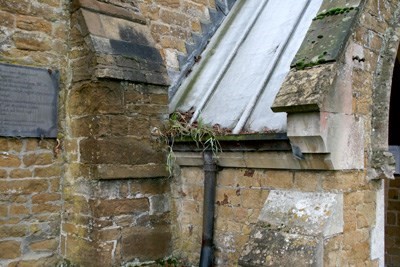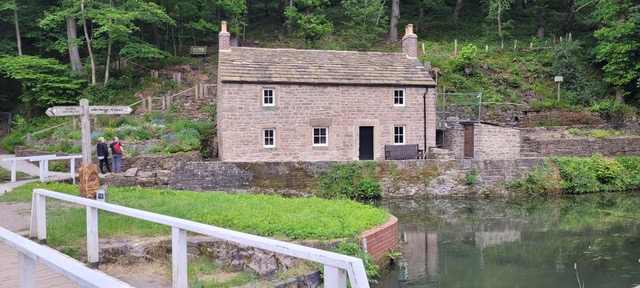Care and maintenance of rainwater goods
 Gutters blocked by debris or growing vegetation will lead to problems with the roofs and walls.
Gutters blocked by debris or growing vegetation will lead to problems with the roofs and walls. Photo courtesy of Historic England'Rainwater goods' is a term that covers a variety of different means of shedding rainwater away from a building. Most commonly seen as attached iron guttering, rainwater goods can also be incorporated, unseen, into the building’s fabric, behind parapets and within walls.
Photo courtesy of Historic England'Rainwater goods' is a term that covers a variety of different means of shedding rainwater away from a building. Most commonly seen as attached iron guttering, rainwater goods can also be incorporated, unseen, into the building’s fabric, behind parapets and within walls.
The need to shed rainwater away from the walls has been recognized for a long time. Medieval churches are famed for their decorative gargoyles and impressive spouts, simple yet effective ways of doing the job. However, in a modern urban setting these means of draining a roof would be rather hazardous for passers-by and churches are more commonly seen with guttering, chutes and downpipes.
Once the water reaches the ground in an urban or suburban church it will enter the sewerage system via underground gullies. In rural churches, which are often not served by mains drainage, gullies normally lead to soakaways.
Rainwater goods are often a designed-in part of the church’s architecture. In the case of listed historic buildings they are protected as historic fixtures and fittings. Often parts of the system are decorated to enhance the appearance of the church, especially in lead or cast iron. Rainwater goods were also a favourite place to record dates, which are frequently seen cast into hoppers.
Why is it important to shed water?
Water is the main agent of decay in historic buildings. Blocked, cracked or badly-designed rainwater goods can allow water into the walls and roof timbers of a church building. The resulting damp encourages timber decay through fungal attack and insect infestation. In the winter months water can penetrate the surface of masonry and freeze, causing stonework to crumble.
If the water is not effectively channelled away from the building at ground level this can cause excessive amounts of moisture to build up in the ground immediately surrounding the church. This can cause movement in the ground (heave), causing cracks in walls and distortions in doorways and windows. Water can also be drawn up the wall from the foundations (rising damp), causing damage to internal plasterwork.
Older church buildings may have been fitted with a variety of different rainwater disposal systems during their life and it should not be assumed that the existing system is necessarily up to the job or appropriate for the particular type of building.
In a listed church the rainwater goods will be considered part of the listed structure, although this need not be an insurmountable obstacle to their replacement if they are inadequate or inappropriate to the building.

Marley Alutec helps to save Aqueduct Cottage
Marley Alutec guttering solutions have been installed during a refurbishment project at Aqueduct Cottage in Derbyshire. The volunteer-led project specified the company’s solutions to ensure a long-lasting, durable installation on the historic building without the need to bring in any external tradespeople.
Click here for the full story
Quinquennial Inspection
Rainwater goods are checked as part of the quinquennial inspection in all Anglican Churches. The recommendations of the Quinquennial Inspector (QI) should be followed up particularly promptly if a major fault is noted with the rainwater disposal system. However, not all types of rainwater goods may be accessible during the inspection, so a clean bill of health from the QI does not mean that gutters and drains can then be ignored for the next five years.
The beginnings of problems might not be obvious to the Inspector during a dry period in summer, and yet will probably have caused a lot of expensive damage before the next inspection is due. It is strongly advised under the QI system that gutters are checked and cleared at least
What prevents gutters from working properly?
Gutters at roof level intercept water as it runs of the roof slopes of a building. However, water is not all they have to deal with. In autumn, leaves can block gutters within days, as can stray balls, beer cans, plastic bags and dead pigeons. Fragments of tile, slate, fallen stonework and other mineral matter can cause a build up of silt in parts of the system where water flow is slow. Plants can then establish themselves in the gutter itself, the ubiquitous Buddleia being a particular problem.
Iron gutters and downpipes can corrode, while plastic ones become brittle and crack, allowing water to escape and enter the building. Damage can also occur to guttering when ladders are leaned against them and downpipes are vulnerable to vandalism. Older lead and iron pipes may have inadequate joints between pipes where water can seep out.
Underground drains are often of the Victorian ceramic type and can be damaged by ground movement, heavy vehicles or tree roots. If the underground drains become completely blocked the system can back up bringing huge pressure to bear on the joints and fixings of pipes further up the system.
What are the signs for problems?
Outside:
Leaves! If your church is in the vicinity of broadleaf trees, a careful eye should be kept on the roof to see if leaves are collecting up there. The rainwater disposal system may continue to function effectively even while dealing with a heavy fall of leaves, but extra vigilance should be exercised.
Signs of rust staining on external walls in the vicinity of iron downpipes. They may be due to corroding wall fixings rather than leaking pipes, but it should be checked out.
Signs of 'green' in the vicinity of drain pipes. Stonework or pipes going green is a sign of constant dampness in that area.
When it rains very heavily for a brief period most gutter systems can overflow. However, if the gutters are seen to overflow constantly during only moderate rain it is a definite sign that there is a problem somewhere. Keep an eye on and regularly clear gullies at ground level.
Inside:
The early stages of damp penetration can be difficult to see. Areas of painted plaster may change colour and look patchy. As the dampness worsens areas of plaster may become detached from the underlying masonry.
Signs of damp high on a wall will almost certainly relate to the gutters or the roof. In heavy rain, water may be seen to enter through the roof and flow from the tops of walls.
Dampness further down the walls may be seen to relate to specific downpipes on the exterior of the walls. Dampness below two metres may be caused by problems in underground drains.
Metal Theft
Another obvious problem will occur if part of the system is missing. Lead, copper and iron drain pipes are all potential targets for thieves. When replacing stolen metalwork it is assumed that the replacement will be like-for-like and that appropriate action will be taken (where possible) to discourage theft in the future.
In some circumstances it is not practical to replace like-for-like, in such cases a visually appropriate alternative can usually be found (e.g. cast aluminium). Plastic is not normally appropriate except for very short term temporary repairs (e.g. when downpipes have been stolen before like for like repairs can be carried out).
Repair to rainwater goods
Normally it is expected that repairs to rainwater goods will be carried out like-for-like; that is, the design and materials of the existing system will be adhered to in any repairs. This is especially important for listed churches.
Exceptions to this general rule might include, replacement of late-20th century plastic rainwater goods with more durable alternatives, alterations to systems that have proved inadequate, and in exceptional cases the substitution of a less valuable material in an area of the church vulnerable to theft.
Particular issues are encountered when repairing or replacing cast iron gutters and downpipes. The cost of cast iron ware is high. It is not usually feasible to dismantle and reassemble cast iron in order to eliminate leaks, as the joints corrode. This tends to result in the need to replace totally what is mainly a sound installation. Sometimes it is possible to limit replacement to one or more sides of the building.
If cast iron is too expensive, cast aluminium to the same architectural profile may be considered or (occasionally) extruded aluminium (i.e. squeezed through a shaped mould), but not a profile bent from flat sheet.
Plastics are almost never acceptable, especially in combination with other materials as the joints do not mate.
Permission for repairs
Like-for-like replacement of gutters and downpipes does not require a faculty, but does require an Archdeacon’s Letter of Authority or ‘List B’ letter. Any change of materials from the existing (even to return to an original design) will automatically mean a faculty is needed.
Instructions on how to apply for a faculty can be found here.
The Diocesan Gutter Maintenance Scheme
The Diocese of London runs a gutter maintenance scheme which aims to clean the gutters of every church twice a year. It can be difficult to gain access to gutters safely without specialist equipment. Once the gutter cleaning company has gained access they may also undertake small scale repairs to gutters and roofs if they are found to be necessary.
Courtesy of the Parish Property Support Team, Diocese of London
Hinowa spider boom ‘vital’ for conserving ancient cathedral for future generations
A cathedral that dates back almost 1,000 years is being maintained in a condition that promises to see it thrive as a place of worship for centuries to come with the help of a Hinowa spider lift.
Expert teams dedicated to conserving Winchester Cathedral, in Hampshire, are using the Hinowa Lightlift 14.70 IIIS for multiple maintenance tasks inside and outside the ancient building.
Click here to read the full story.

Giant cistern is master leadworker’s latest achievement
The latest bespoke creation from traditional leadworker Brian Turner is a large cistern created for a historic house in west Norfolk. Cisterns are large vessels, made popular in the Georgian era, used to store rainwater for use in irrigation of a garden.
The particular cistern was commissioned for the rear of the house. The front elevation of the house, dating from the early 16th century, is depicted on the central panel of the cistern, together with design details of the building.
Click here to read the full story.














